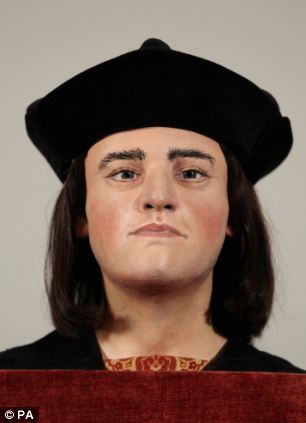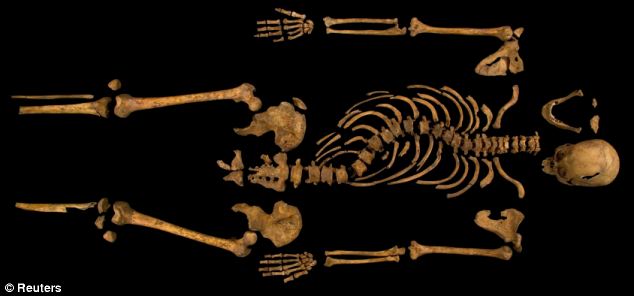King Richard III, whose remains were found last year under a car park in Leicester, suffered from roundworm, analysis has revealed.
Scientists found roundworm eggs in a soil sample taken from the pelvis of the skeleton of the king, which was discovered last year by archaeologists at the University of Leicester.
Since the body of King Richard III was found, scientists have been undertaking careful analysis of the remains, in an attempt to shed further light on the attributes and history of the controversial king.
For centuries it was believed by many of Richard III's supporters that he wasn't as bad as many believe him to be - for example, he is rumoured to have murdered his nephews, the Princes in the Tower, one of whom was King Edward V, although their fate still remains a mystery - and that his bad reputation was started by the Tudors, who were the ones who defeated him, and that it was they, including Shakespeare, who falsely claimed that he was a hunchback in order to make him look evil.
But the remains of Richard III show that the Tudors were actually right - Richard III did indeed have a hunchback.
The Yorkist King Richard III was killed and defeated by the Lancastrian forces of Henry Tudor during the Battle of Bosworth in 1485 - Henry Tudor became King Henry VII, the first Tudor monarch.
Richard III was riddled with ROUNDWORM in his dying days, analysis of skeleton reveals
4 September 2013

Richard III (a model of how he looked, based on his skull, is pictured) not only had a hunchback but he also suffered from roundworm infection, new research has revealed
Richard III not only had a hunchback but he also suffered from roundworm infection, research has revealed.
Scientists found roundworm eggs in a soil sample taken from the pelvis of the skeleton of the king, which was discovered last year by archaeologists at the University of Leicester.
Since the body of King Richard III was found, scientists have been undertaking careful analysis of the remains, in an attempt to shed further light on the attributes and history of the controversial king.
A team of researchers led by Dr Piers Mitchell, of the Department of Archaeology and Anthropology at the University of Cambridge, used a powerful microscope to examine soil samples taken from the skeleton’s pelvis and skull, as well as from the soil surrounding the grave.
The microscope revealed multiple roundworm eggs in the soil sample taken from the pelvis, where the intestines would have been situated in life.
However, there was no sign of eggs in soil from the skull and very few eggs in the soil that surrounded the grave, suggesting that the eggs found in the pelvis area resulted from a genuine roundworm infection during his life, rather than from external contamination by the later dumping of human waste in the area.
Roundworms are parasitic nematodes which infect humans when people ingest their eggs via contaminated food, water, or soil.

There was no sign of eggs in soil from the skeleton's skull and very few eggs in the soil that surrounded the grave, suggesting that the eggs found in the pelvis area resulted from a genuine roundworm infection during the king's life. Roundworms are pictured

Dr Jo Appleby at the University of Leicester, said: 'Despite Richard's noble background, it appears that his lifestyle did not protect him from intestinal parasite infection, which would have been very common at the time.' The skeleton of Richard III, which was discovered at the Grey Friars excavation site in Leicester, is pictured
Once eaten, the eggs hatch into larvae, which migrate through the tissues of the body to the lungs where they mature.
They then crawl up the airways to the throat to be swallowed back into the intestines, where they can grow into adults around a foot long.
Roundworm infection is thought to be one of the common health conditions in the world, affecting up to a quarter of all people globally, although it is rare in Britain today.
Dr Mitchell said: 'Our results show that Richard was infected with roundworms in his intestines, although no other species of intestinal parasite were present in the samples we studied.

On screen: Aneurin Barnard plays Richard, Duke of Gloucester - the future Richard III - in the BBC TV series The White Queen

Also featured: Other characters in The White Queen include (l-r) Lady Margaret Beaufort , the Lancastrian mother of Henry Tudor, who would defeat Richard at Bosworth to become Henry VII, the first Tudor monarch (played by Amanda Hale), Elizabeth Woodville, the wife of Richard's brother Edward IV and the grandmother of the future Henry VIII (Rebecca Ferguson) and Richard's consort Anne Neville (Faye Marsay)
'We would expect nobles of this period to have eaten meats such as beef, pork and fish regularly, but there was no evidence for the eggs of the beef, pork or fish tapeworm. This may suggest that his food was cooked thoroughly, which would have prevented the transmission of these parasites.'
Dr Jo Appleby, lecturer in human bioarchaeology at the University of Leicester, said: 'Despite Richard’s noble background, it appears that his lifestyle did not completely protect him from intestinal parasite infection, which would have been very common at the time.'
The Dig for Richard III was led by the University of Leicester, working with Leicester City Council and in association with the Richard III Society.
WHAT ARE ROUNDWORMS?
Roundworms are parasitic nematodes which infect humans when people ingest their eggs via contaminated food, water, or soil.
Once eaten, the eggs hatch into larvae, which migrate through the tissues of the body to the lungs where they mature.
They then crawl up the airways to the throat to be swallowed back into the intestines, where they can grow into adults around a foot long.
Read more: Was Richard III troubled by a medical condition in his dying days? Analysis reveals he was suffering with ROUNDWORM | Mail Online
Scientists found roundworm eggs in a soil sample taken from the pelvis of the skeleton of the king, which was discovered last year by archaeologists at the University of Leicester.
Since the body of King Richard III was found, scientists have been undertaking careful analysis of the remains, in an attempt to shed further light on the attributes and history of the controversial king.
For centuries it was believed by many of Richard III's supporters that he wasn't as bad as many believe him to be - for example, he is rumoured to have murdered his nephews, the Princes in the Tower, one of whom was King Edward V, although their fate still remains a mystery - and that his bad reputation was started by the Tudors, who were the ones who defeated him, and that it was they, including Shakespeare, who falsely claimed that he was a hunchback in order to make him look evil.
But the remains of Richard III show that the Tudors were actually right - Richard III did indeed have a hunchback.
The Yorkist King Richard III was killed and defeated by the Lancastrian forces of Henry Tudor during the Battle of Bosworth in 1485 - Henry Tudor became King Henry VII, the first Tudor monarch.
Richard III was riddled with ROUNDWORM in his dying days, analysis of skeleton reveals
- University of Cambridge research revealed multiple roundworm eggs in the soil sample taken from the pelvis, where the intestines would have been
- The situation of the eggs suggests the king suffered a genuine roundworm infection during his life
- Despite Richard’s social status, it appears that his lifestyle did not protect him from the intestinal parasite infection, which was common at the time
4 September 2013

Richard III (a model of how he looked, based on his skull, is pictured) not only had a hunchback but he also suffered from roundworm infection, new research has revealed
Richard III not only had a hunchback but he also suffered from roundworm infection, research has revealed.
Scientists found roundworm eggs in a soil sample taken from the pelvis of the skeleton of the king, which was discovered last year by archaeologists at the University of Leicester.
Since the body of King Richard III was found, scientists have been undertaking careful analysis of the remains, in an attempt to shed further light on the attributes and history of the controversial king.
A team of researchers led by Dr Piers Mitchell, of the Department of Archaeology and Anthropology at the University of Cambridge, used a powerful microscope to examine soil samples taken from the skeleton’s pelvis and skull, as well as from the soil surrounding the grave.
The microscope revealed multiple roundworm eggs in the soil sample taken from the pelvis, where the intestines would have been situated in life.
However, there was no sign of eggs in soil from the skull and very few eggs in the soil that surrounded the grave, suggesting that the eggs found in the pelvis area resulted from a genuine roundworm infection during his life, rather than from external contamination by the later dumping of human waste in the area.
Roundworms are parasitic nematodes which infect humans when people ingest their eggs via contaminated food, water, or soil.

There was no sign of eggs in soil from the skeleton's skull and very few eggs in the soil that surrounded the grave, suggesting that the eggs found in the pelvis area resulted from a genuine roundworm infection during the king's life. Roundworms are pictured

Dr Jo Appleby at the University of Leicester, said: 'Despite Richard's noble background, it appears that his lifestyle did not protect him from intestinal parasite infection, which would have been very common at the time.' The skeleton of Richard III, which was discovered at the Grey Friars excavation site in Leicester, is pictured
Once eaten, the eggs hatch into larvae, which migrate through the tissues of the body to the lungs where they mature.
They then crawl up the airways to the throat to be swallowed back into the intestines, where they can grow into adults around a foot long.
Roundworm infection is thought to be one of the common health conditions in the world, affecting up to a quarter of all people globally, although it is rare in Britain today.
Dr Mitchell said: 'Our results show that Richard was infected with roundworms in his intestines, although no other species of intestinal parasite were present in the samples we studied.

On screen: Aneurin Barnard plays Richard, Duke of Gloucester - the future Richard III - in the BBC TV series The White Queen

Also featured: Other characters in The White Queen include (l-r) Lady Margaret Beaufort , the Lancastrian mother of Henry Tudor, who would defeat Richard at Bosworth to become Henry VII, the first Tudor monarch (played by Amanda Hale), Elizabeth Woodville, the wife of Richard's brother Edward IV and the grandmother of the future Henry VIII (Rebecca Ferguson) and Richard's consort Anne Neville (Faye Marsay)
'We would expect nobles of this period to have eaten meats such as beef, pork and fish regularly, but there was no evidence for the eggs of the beef, pork or fish tapeworm. This may suggest that his food was cooked thoroughly, which would have prevented the transmission of these parasites.'
Dr Jo Appleby, lecturer in human bioarchaeology at the University of Leicester, said: 'Despite Richard’s noble background, it appears that his lifestyle did not completely protect him from intestinal parasite infection, which would have been very common at the time.'
The Dig for Richard III was led by the University of Leicester, working with Leicester City Council and in association with the Richard III Society.
WHAT ARE ROUNDWORMS?
Roundworms are parasitic nematodes which infect humans when people ingest their eggs via contaminated food, water, or soil.
Once eaten, the eggs hatch into larvae, which migrate through the tissues of the body to the lungs where they mature.
They then crawl up the airways to the throat to be swallowed back into the intestines, where they can grow into adults around a foot long.
Read more: Was Richard III troubled by a medical condition in his dying days? Analysis reveals he was suffering with ROUNDWORM | Mail Online
Last edited:


